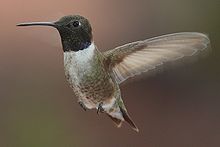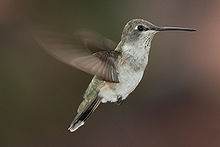Black-chinned hummingbird
| Black-chinned hummingbird | |
|---|---|
 |
|
| Male | |
 |
|
| Female | |
| Scientific classification | |
| Kingdom: | Animalia |
| Phylum: | Chordata |
| Class: | Aves |
| Order: | Apodiformes |
| Family: | Trochilidae |
| Genus: | Archilochus |
| Species: | A. alexandri |
| Binomial name | |
|
Archilochus alexandri (Bourcier & Mulsant, 1846) |
|
 |
|
| Global range Year-Round Range Summer Range Winter Range | |
The black-chinned hummingbird (Archilochus alexandri) is a small hummingbird. It is an extremely adaptable bird, occupying a broad range of habitats.
They are migratory and spend most of the winter in Mexico.
A hybrid between this species and Anna's hummingbird was called "Trochilus" violajugulum. The black-chinned hummingbird is also known to hybridize with Costa's hummingbird.
As of 2011, it has the smallest known genome of all living amniotes, only 0.91 pg (910 million base pairs).
The black-chinned hummingbird is 8.25 cm (3.25 in) long. Adults are metallic green above and white below with green flanks. Their bill is long, straight and very slender. The adult male has a black face and chin, a glossy purple throat band and a dark forked tail. The female has a dark rounded tail with white tips and no throat patch; they are similar to female ruby-throated hummingbirds. Juvenile plumage is similar to that of adult females, but with buff margins on the dorsal feathers. Juvenile males may also possess purple feathers on their throats.
Young are born almost featherless, but obtain a complete set of feathers within three weeks of hatching. Juveniles can begin replacing their plumage in November, and acquire their first basic plumage between April and May. Molts will then occur annually, taking 7–8 months at the population level.
Similar species to the black-chinned hummingbird include broad-tailed hummingbird, rufous hummingbird, calliope hummingbird, Allen's hummingbird, lucifer hummingbird, Anna's hummingbird, and Costa's hummingbird.
Black-chinned hummingbirds are found in most of the western United States, reaching north into Canada in Alberta and British Columbia, east to Oklahoma, and as far south as Mexico. They can be found in mountains, woodlands, orchards, meadows, and chaparral habitats. Their breeding habitat is open, semiarid areas, usually near water in the western United States, northern Mexico, and southern British Columbia.
...
Wikipedia

